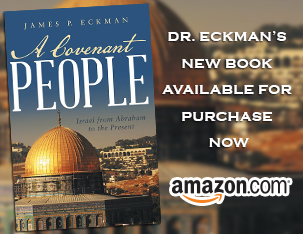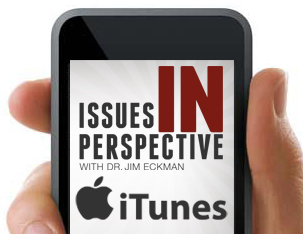Personal Faith, TikTok And Social Media
Apr 5th, 2025 | By Dr. Jim Eckman | Category: Culture & Wordview, Featured IssuesThe mission of Issues in Perspective is to provide thoughtful, historical and biblically-centered perspectives on current ethical and cultural issues.

Moral and spiritual formation is at the heart of any heathy society. From a biblical perspective, moral and spiritual formation involves at least three dimensions of the human condition that need development and shaping. God’s Word, the Holy Spirit and the encouragement and edification that comes from being with likeminded believers shape the heart (being kind, considerate, generous), the mind (being curious, open-minded, having good judgment) and the will (self-control, determination courage).
Is the social media phenomenon a help or a hindrance in the process of moral and spiritual formation? Nicholas Carr, author of a new book entitled Superbloom: How Technologies of Connection Are Tearing Us Apart, has written, “Social media is not successful because it goes against our instincts and desires. It’s successful because it gives us what we want.” More communication does not necessarily lead to more understanding. “By removing barriers to communication, social media has enabled us to let loose our worst instincts and transmit to a huge audience whatever thougtlet comes to mind . . . Different points of view are seen not as opportunities to learn but as provocations to attack.”
Furthermore, social media is profoundly affecting how humans process spiritual truth and therefore it affects moral and spiritual formation. Consider a recent article in The Economist on the impact of TikTok. [Donald Trump issued an executive order on his first day back in office, granting an extension before the Chinese-owned app would be divested or shut down due to American concerns over national security.] It is important to reflect on the spiritual impact of TikTok: “Sacred sentiments are not out of place on TikTok, where religious content is booming among the app’s 1.9bn global users (none of whom are in China, where it is not available). Videos with the top five holy hashtags, including #Jesus and #Islam, have been viewed more than 1.2trn times. ‘FaithTok,’ as some call the platform’s congregation, is eclectic. Videos show Catholics sprinkling holy water, Mormons annotating scripture and Muslims reciting the Koran. Nuns provide glimpses of convent life; imams proffer guidance; and congregants try to launch their own congregations. TikTok offers a cacophony of liturgy, which sometimes baffles as much as it enlightens. But it is worth more attention, because the app is changing faith and culture in notable ways.”
This is not the first time technology has influenced moral and spiritual formation. The printing press was famously disruptive, spurring on the Protestant Reformation in 1517. Television helped evangelism flourish in America in the 20th century, though it was also linked to lower church attendance. After the internet boom in the 1990s, people in the West started shedding their formal religious affiliations. Since then the share of Americans who say they have “no religion” has almost tripled, to 28%, surpassing every other denomination.
Online there are “so many religious truth claims floating around that it undercuts your certainty”, explains Paul McClure, a sociologist at the University of Lynchburg in Virginia. As people spend more time on the internet, they are less likely to pray, attend services or belong to a religious tradition. “That does not mean social media have been all bad for religion: online platforms have sometimes helped build religious communities through forums and chat rooms, including during covid. And inundated with multiple belief systems, pushed through algorithms, research has found that young adults on social media have become more accepting of different religions.”
“TikTok is the loudest pulpit yet.” The app is “social media on steroids”, according to Nathan Mladin of Theos, a Christian think-tank. “TikTok is changing faith in three ways.”
- First, conversions are occurring differently, especially among young people, who are not always attracted to established religious figures. Instead, they gravitate to FaithTokers, who sometimes peddle products that are “in line with scripture”, such as halal snacks and sportswear emblazoned with Bible verses. Their videos offer new rituals (“holy girl habits”), slogans (“God is so cool!”) and counsel in verse (“When in doubt, worship it out”). Influencers who tout “the Jesus glow” have seen great success on a platform where personal beauty advice flourishes. Gen Z, TikTok’s biggest flock of users, is more likely than any other generation to think faith has a place in the modern world, according to a study by Theos. Young proselytes are often attracted not to established churches but to online ministries. “Short-form content was . . . a gift from God,” says Taylan Michael Seaman, a Louisianan influencer who runs a digital ministry and helps other Christians form their own. Seaman claims to have started a “viral revival”, training a thousand preachers and inspiring some 750,000 “salvations”, or conversions.
- A second way TikTok is changing faith is by making it less formal. Gen Z does not want “smoke and mirrors”, argues Gabe Poirot, an influencer who claims to have converted some 40,000 people to Christianity. Young people prefer unedited clips to polished productions. Some are leaving church pews, he thinks, to develop a more “intimate relationship with Jesus” online. Pared-back sermons and the parasocial relationships many netizens forge with online influencers offer some semblance of closeness to God. TikTok’s casual style also means that anyone with a phone and internet connection can start preaching, says Denis Bekkering, an expert on online evangelism. Influencers are lauded for their charisma rather than their credentials; those with large followings have little training. On top of that, creators are incentivized to provoke or pander to their audience for views.
- This points to one of TikTok’s biggest effects on faith: it is sowing division. As ever more voices proclaim authority, people’s belief systems have splintered. Much as worshippers abandoned the Catholic Church during the Reformation, today they are leaving traditional institutions to follow new religions. The vitality of unorthodox beliefs undermines dominant authorities. Influencers’ ministries are often “non-denominational”, espousing views separate from any established sect. On the outer fringes of FaithTok people are defecting to “new age” spirituality. #Wicca and #Witchcraft each have billions of views on the platform, as youngsters extol crystals, potions and spells. FaithTok is awash in religious disinformation, from AI-generated hate speeches to deepfakes of prominent religious leaders. Spiritually minded conspiracy theories (dubbed “conspirituality”) spread rapidly on TikTok and beyond. For example, “QAnon” conspiracies are prevalent, infused with religious imagery and positioned as spiritual quests. Faith is a mobilizing force, because believers think they are being summoned for a higher purpose, says Joan Donovan, a disinformation scholar at Boston University. “Religious disinformation can be as divisive as the political sort, Ms. Donovan says. Online, many of the lambs of God turn into lions.”
The impact of social media on issues of faith has produced an unexpected result: “After years of decline, the Christian population in the United States has been stable for several years, a shift fueled in part by young adults, according to a major new survey from the Pew Research Center. And the number of religiously unaffiliated Americans, which had grown steadily for years, has also leveled off.” “We’re entering a new era of the American religious landscape,” said Ryan Burge, a political scientist at Eastern Illinois University who was not involved in the Pew survey. The “nones” — those in the American population who tell researchers they have no religious affiliation — have been growing for decades. “Now that growth has either slowed or stopped completely,” Dr. Burge said, “and that’s big deal.”
These findings come from the Religious Landscape Survey, a survey of more than 35,000 randomly selected adults from across the country conducted in 2023 and 2024. The last survey was published in 2014, making the new edition’s release a major update in the understanding of American spiritual beliefs and practice. Ruth Graham of the New York Times provides a summary of the most salient findings:
- The survey finds that 62 percent of adults in the United States describe themselves as Christians, including 40 percent who identify as Protestant and 19 percent who are Catholic. Overall, that represents a decline in the share of Christians since the survey was first published in 2007. As recently as the early 1990s, nine in 10 adults in the country identified as Christian. Almost 30 percent of adults participating in the new survey are religiously unaffiliated, and 7 percent identify with a religion other than Christianity.
- The survey’s first two editions have shown each age group becoming steadily less Christian than the previous. For example, 80 percent of those born in the 1940s or earlier now identify as Christian, compared with 75 percent of those born in the 1950s and 73 percent of those born in the 1960s. People in the youngest age group in the new survey, born between 2000 and 2006, appear to defy that trend. They are still less likely than average to identify as Christian, and far less likely than the oldest Americans. But, intriguingly to researchers, they appear no less religious than survey participants in the second-youngest cohort, born in the 1990s. The youngest survey participants stood out in other ways, too. The gap in religiosity between men and women is far smaller than it is in older generations. Typically, women are more religious than men on a variety of measures. It’s a pattern so consistent across time, geography and culture that some scholars characterize it as a fact of human life. The pattern shows up in Pew’s oldest cohorts, where, for example, women are 20 points more likely than men to say they pray every day.
- The survey was conducted before President Trump’s re-election and the subsequent “vibe shift” detected by many religious conservatives, a rightward turn that includes celebrity conversions and a Silicon Valley backlash against progressivism. Still, people who are politically conservative and liberal are on dramatically different trajectories religiously, the Pew survey affirms. The share of self-described liberals who identify as Christian has dropped by 25 points since 2007. Just over a third of liberals now identify as Christian, and more than half say they have no religion. Among conservatives, the decline in Christian identification has been much more subtle, to 82 percent from 89 percent.
- Researchers caution that the data does not indicate an actual reversal in the decline of Christianity, or even that the plateau will last. Young adults are still significantly less religious than older adults, meaning they will pull down the average religiosity over time. It is unlikely that the current group of young adults will become more religious as they age. But some experts suggest that most people who were going to leave a religion have done so by now, raising the possibility that the data might offer a hint at the natural ceiling of nonreligiosity in the United States. “The ‘nones’ have run through the easy parts of the market, and now they’re hitting the bedrock of committed evangelicals” and theological traditionalists in other faiths, said Dr. Ryan Burge of Eastern Illinois University, who was also pastor of an American Baptist church for 17 years. Going forward, “if you’re going to make advances, you have to make advances with conservatives.” Regardless of how many Americans identify with specific religions — or no religion at all — in the future, the survey depicts a fundamentally spiritual population. More than 80 percent of survey participants believe humans “have a soul or spirit in addition to their physical body,” and believe in God or a universal spirit.
The social media phenomenon has produced a shallow, superficial religiosity that seems to go against the New Testament’s call for adherence to “sound doctrine” (see the Pastoral Epistles). Furthermore, it seems to violate the warning of Hebrews 10:24-25: “And let us consider how to stir up one another to love and good works; not neglecting to meet together, as is the habit of some, but encouraging one another, and all the more as you see the Day drawing near.” [ESV] Social media may be a helpful tool for evangelism and for instruction, but it cannot substitute for the “gathering together of the saints.”
See David Brooks in the New York Times (10 January 2025); Jennifer Szalai’s review of Carr’s book in the New York Times Book Review, (19 February 2025), p. 9; “How TikTok became a religious pulpit” in The Economist (8 February 2025), pp. 67-68; and Ruth Graham in the New York Times (27 February 2025).


